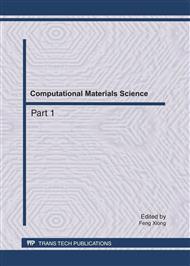[1]
Coventry J, Hickey M W. Growth characteristics of meat starter cultures. Meat Science, 1991, 30 (1): 41-48.
DOI: 10.1016/0309-1740(91)90033-m
Google Scholar
[2]
Aimin Jiang. Technology of animal products. Beijing: China Agricultural Press, (2000).
Google Scholar
[3]
Xueqing Wang and Zhang Wei. Main physicochemical and microorganismal changes in the process of producing dry fermented saugages by using Lactobacillus casei and Staphylococcus as starts. Food and Fermentation Industry, 1998, 23 (6): 6-11.
Google Scholar
[4]
Xianbao Li. The researches and productions of lactic acid bacteria fermented saugages. Meats Study, 1996 (4): 20-24.
Google Scholar
[5]
Hanjun Ma. Changes in physicochemical properties of lactic fermented saugages. Meats Study, 1996 (5): 23-25.
Google Scholar
[6]
Huazhen Cai, Changwei Ma and Jiangbi Xie, etc. The changes of fats in the mature process of dry fermented saugages and its relations with aromatic ingredients. Food Fermentation Industry, 1999 (6): 15-18.
Google Scholar
[7]
Aimin Jiang. Technology of animal products. Beijing: China Agricultural Press, (2005).
Google Scholar
[8]
KALACP. Bilologically active polyam ines in beef, pork and meat products: a review. Meat Science, 2006, 73 (1): 1-11.
DOI: 10.1016/j.meatsci.2005.11.001
Google Scholar
[9]
Xianbao Li. The researches and productions of lactic acid bacteria fermented saugages. Meats Study, 1996 (4): 20-24.
Google Scholar
[10]
GARCIA M L, SELGASM D, FERNANDEZM, etal. Microorganism and lipolysis in the ripening of dry fermented sausages. Food SciTechnol, 2002, 26: 564-567.
Google Scholar
[11]
KENEALLY P M, SCHWAR Z G, FRANSEN N G, etal. Lipolytic starter culture effects on free fatty acid in fermented sausages. Food Rev Int, 1998 (3): 538-543.
DOI: 10.1111/j.1365-2621.1998.tb15781.x
Google Scholar
[12]
CHOCY. Fish nutrition feed and feeding: with special empasis on salmonid aquaculture. Food Rev Int, 2006 (6): 337-357.
Google Scholar
[13]
DRUM T D, SPANIEL A M. Changes in the content of lipid autoxidation and sulphur-containing compounds in cooked beef during storage. Agric Food Chem, 2007, 37: 213-218.
Google Scholar


